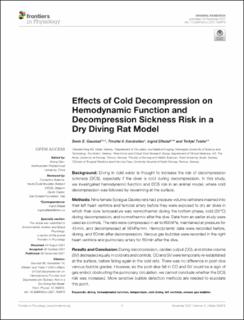| dc.description.abstract | Background: Diving in cold water is thought to increase the risk of decompression sickness (DCS), especially if the diver is cold during decompression. In this study, we investigated hemodynamic function and DCS risk in an animal model, where cold decompression was followed by rewarming at the surface.
Methods: Nine female Sprague Dawley rats had pressure-volume catheters inserted into their left heart ventricle and femoral artery before they were exposed to dry air dives in which their core temperature was normothermic during the bottom phase, cold (35°C) during decompression, and normothermic after the dive. Data from an earlier study were used as controls. The rats were compressed in air to 600kPa, maintained at pressure for 45min, and decompressed at 50kPa/min. Hemodynamic data were recorded before, during, and 60min after decompression. Venous gas bubbles were recorded in the right heart ventricle and pulmonary artery for 60min after the dive.
Results and Conclusion: During decompression, cardiac output (CO), and stroke volume (SV) decreased equally in cold rats and controls. CO and SV were temporarily re-established at the surface, before falling again in the cold rats. There was no difference in post-dive venous bubble grades. However, as the post-dive fall in CO and SV could be a sign of gas emboli obstructing the pulmonary circulation, we cannot conclude whether the DCS risk was increased. More sensitive bubble detection methods are needed to elucidate this point. | en_US |

